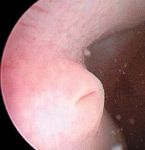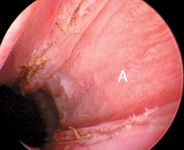Endoscopy Brief: Transurethal cystoscopy and diode laser incision to correct an ectopic ureter
An 8-week-old 16.5-lb (7.5-kg) female Labrador retriever puppy was presented for evaluation of urinary incontinence. The puppy's incontinence had been present since the owner obtained the puppy at 4 weeks of age.
An 8-week-old 16.5-lb (7.5-kg) female Labrador retriever puppy was presented for evaluation of urinary incontinence. The puppy's incontinence had been present since the owner obtained the puppy at 4 weeks of age.
The physical examination revealed that the perineal area was constantly wet, and anything that the puppy was placed on became saturated with urine within minutes. The results of a complete blood count, a serum chemistry profile, thoracic and abdominal radiography, and electrocardiography were normal. A urinalysis revealed pyuria (25 to 30 WBC/HPF), bacteriuria (2+ rods), and a specific gravity of 1.032. Urine culture results were positive for Klebsiella pneumoniae and Proteus mirabilis. An ectopic ureter was tentatively diagnosed, and transurethral cystoscopy was planned.

Figure 1. The opening of the right ectopic ureter in the distal urethra.
The patient was premedicated with acepromazine and glycopyrrolate given subcutaneously. Anesthesia was induced with intravenous propofol and was maintained with inhalant sevoflurane. Lactated Ringer's solution was administered intravenously during the procedure. The puppy was placed in left lateral recumbency, and diagnostic transurethral cystoscopy was performed by using a 2.7-mm-diameter rigid telescope (model 64018 BSA—Karl Storz Veterinary Endoscopy) and saline irrigation.

Figure 2. The opening of the normal left ureter in the bladder.
The patient was then placed in ventral recumbency, and cystoscopy revealed an ectopic right ureter opening into the distal urethra within one centimeter of the urethral orifice (Figure 1) and a normal left ureteral stoma opening into the bladder (Figure 2). The urethra was dilated, and the ectopic ureter could be seen as a ridge coursing the full length of the urethra (Figure 3). The bladder appeared normal, and clear urine flowed from the normal left ureter into the bladder and from the ectopic right ureteral stoma into the distal urethra.

Figure 3. The right ectopic ureter is visible as the ridge (arrow) in the urethra proximal to the opening of the ureter as shown in Figure 1.
During this procedure, a diode laser was used with cystoscopic guidance to transect the free wall of the ectopic ureter (Figure 4) from its ectopic stoma in the distal urethra for the full length (about 3 to 4 cm) of the urethra (Figure 5) and to create a new stoma at the level of the contralateral normal stoma within the bladder. A flexible 1,000-µm quartz diode laser fiber was passed through the biopsy channel of the endoscope operating sheath (model 67065C—Karl Storz Veterinary Endoscopy) and connected to a 980-nm-wavelength 50-W diode laser (AccuVet 50D—AccuVet Laser Surgery) set on continuous mode with a power setting of 20 W. The tip of the laser fiber was inserted into the ectopic ureter lumen, and the laser was activated to cut the free wall of tissue separating the ureteral lumen from the urethral lumen cranially into the bladder to the level of the normal contralateral ureteral stoma (Figure 6). The right ureter thus opened in the bladder in a normal location, and there was no longer a ureteral lumen in the urethra. Urine flowed from the ureter into the bladder normally. The entire procedure was performed using transurethral cystoscopy; open surgery was not required.

Figure 4. Cutting the free wall of the ectopic ureter, or septum between the ureter (A = ureteral lumen) and the urethral lumen (B), with the diode laser (C = laser fiber).
The patient had an uneventful recovery, urinated normally after the procedure, and was discharged from the hospital the next day. Cephalexin and butorphanol were prescribed. The owner was instructed to allow the dog normal activity and frequent opportunities to urinate, to follow the normal feeding regimen, and to provide normal access to water.

Figure 5. The cut free wall or septum in the urethra showing the opened lumen of the ureter (A = ureteral mucosa) as one continuous lumen with the urethra.
Follow-up examinations at two weeks and at two months after the procedure confirmed the complete resolution of the incontinence and revealed normal urinalysis results. A phone report a year after the procedure indicated that the dog had minimal intermittent incontinence, which started after an ovariohysterectomy was performed; the incontinence was well-controlled with phenylpropanolamine (30 mg orally b.i.d.).
Conclusion
The advantages of transurethral cystoscopic ectopic ureter correction using a diode laser are that it can be performed at the same time as the diagnostic transurethral cystoscopy, that it takes only about five minutes, and that it is minimally invasive with minimal tissue trauma. And if resolution of incontinence is achieved, open ectopic ureter surgery is avoided.

Figure 6. The new right ureteral stoma for the ectopic ureter in the bladder (A = bladder lumen).
The disadvantages and complications of this technique have not been defined but potentially include the expense of the equipment, an inability to correct all types of ectopic ureters, penetration of the urethral or bladder walls with the laser, and stricture formation at the new stoma site.
Five other patients with ectopic ureters corrected with this technique have also had marked improvement in incontinence, which is controlled with medication.1 However, more cases are needed to define case selection criteria and rate of success and to refine the operative technique.
"Endoscopy Brief" was contributed by Timothy C. McCarthy, DVM, PhD, DACVS, Surgical Specialty Clinic for Animals, 4525 S.W. 109th Ave., Beaverton, OR 97005.

Timothy C. McCarthy
REFERENCE
1. Rawlings C, University of Georgia, Athens, Ga: Personal communication, 2006.
Newsletter
From exam room tips to practice management insights, get trusted veterinary news delivered straight to your inbox—subscribe to dvm360.